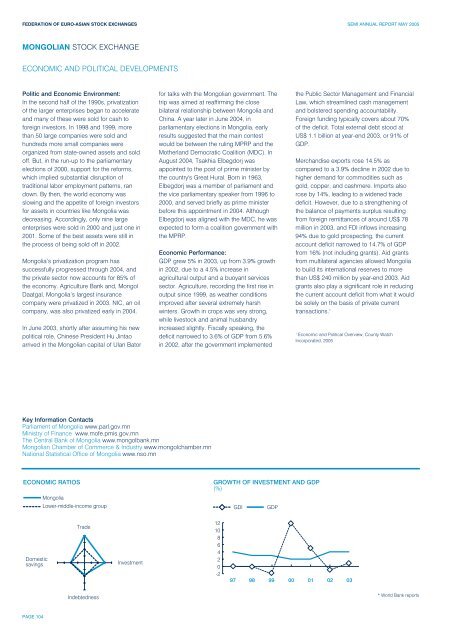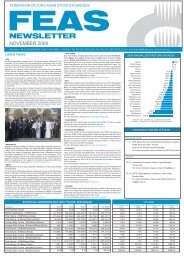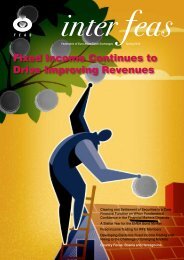Download - FEAS xxx.fh9
Download - FEAS xxx.fh9
Download - FEAS xxx.fh9
You also want an ePaper? Increase the reach of your titles
YUMPU automatically turns print PDFs into web optimized ePapers that Google loves.
FEDERATION OF EURO-ASIAN STOCK EXCHANGES SEMI ANNUAL REPORT MAY 2005<br />
MONGOLIAN STOCK EXCHANGE<br />
ECONOMIC AND POLITICAL DEVELOPMENTS<br />
Politic and Economic Environment:<br />
In the second half of the 1990s, privatization<br />
of the larger enterprises began to accelerate<br />
and many of these were sold for cash to<br />
foreign investors. In 1998 and 1999, more<br />
than 50 large companies were sold and<br />
hundreds more small companies were<br />
organized from state-owned assets and sold<br />
off. But, in the run-up to the parliamentary<br />
elections of 2000, support for the reforms,<br />
which implied substantial disruption of<br />
traditional labor employment patterns, ran<br />
down. By then, the world economy was<br />
slowing and the appetite of foreign investors<br />
for assets in countries like Mongolia was<br />
decreasing. Accordingly, only nine large<br />
enterprises were sold in 2000 and just one in<br />
2001. Some of the best assets were still in<br />
the process of being sold off in 2002.<br />
Mongolia’s privatization program has<br />
successfully progressed through 2004, and<br />
the private sector now accounts for 85% of<br />
the economy. Agriculture Bank and, Mongol<br />
Daatgal, Mongolia’s largest insurance<br />
company were privatized in 2003. NIC, an oil<br />
company, was also privatized early in 2004.<br />
In June 2003, shortly after assuming his new<br />
political role, Chinese President Hu Jintao<br />
arrived in the Mongolian capital of Ulan Bator<br />
Key Information Contacts<br />
Parliament of Mongolia www.parl.gov.mn<br />
Ministry of Finance www.mofe.pmis.gov.mn<br />
The Central Bank of Mongolia www.mongolbank.mn<br />
Mongolian Chamber of Commerce & Industry www.mongolchamber.mn<br />
National Statistical Office of Mongolia www.nso.mn<br />
ECONOMIC RATIOS<br />
Domestic<br />
savings<br />
PAGE 104<br />
Mongolia<br />
Lower-middle-income group<br />
Trade<br />
Indebtedness<br />
Investment<br />
for talks with the Mongolian government. The<br />
trip was aimed at reaffirming the close<br />
bilateral relationship between Mongolia and<br />
China. A year later in June 2004, in<br />
parliamentary elections in Mongolia, early<br />
results suggested that the main contest<br />
would be between the ruling MPRP and the<br />
Motherland Democratic Coalition (MDC). In<br />
August 2004, Tsakhia Elbegdorj was<br />
appointed to the post of prime minister by<br />
the country's Great Hural. Born in 1963,<br />
Elbegdorj was a member of parliament and<br />
the vice parliamentary speaker from 1996 to<br />
2000, and served briefly as prime minister<br />
before this appointment in 2004. Although<br />
Elbegdorj was aligned with the MDC, he was<br />
expected to form a coalition government with<br />
the MPRP.<br />
Economic Performance:<br />
GDP grew 5% in 2003, up from 3.9% growth<br />
in 2002, due to a 4.5% increase in<br />
agricultural output and a buoyant services<br />
sector. Agriculture, recording the first rise in<br />
output since 1999, as weather conditions<br />
improved after several extremely harsh<br />
winters. Growth in crops was very strong,<br />
while livestock and animal husbandry<br />
increased slightly. Fiscally speaking, the<br />
deficit narrowed to 3.6% of GDP from 5.6%<br />
in 2002, after the government implemented<br />
GROWTH OF INVESTMENT AND GDP<br />
(%)<br />
12<br />
10<br />
8<br />
6<br />
4<br />
2<br />
0<br />
-2<br />
97<br />
GDI GDP<br />
the Public Sector Management and Financial<br />
Law, which streamlined cash management<br />
and bolstered spending accountability.<br />
Foreign funding typically covers about 70%<br />
of the deficit. Total external debt stood at<br />
US$ 1.1 billion at year-end 2003, or 91% of<br />
GDP.<br />
Merchandise exports rose 14.5% as<br />
compared to a 3.9% decline in 2002 due to<br />
higher demand for commodities such as<br />
gold, copper, and cashmere. Imports also<br />
rose by 14%, leading to a widened trade<br />
deficit. However, due to a strengthening of<br />
the balance of payments surplus resulting<br />
from foreign remittances of around US$ 78<br />
million in 2003, and FDI inflows increasing<br />
94% due to gold prospecting, the current<br />
account deficit narrowed to 14.7% of GDP<br />
from 16% (not including grants). Aid grants<br />
from multilateral agencies allowed Mongolia<br />
to build its international reserves to more<br />
than US$ 240 million by year-end 2003. Aid<br />
grants also play a significant role in reducing<br />
the current account deficit from what it would<br />
be solely on the basis of private current<br />
transactions. 1<br />
1 Economic and Political Overview, County Watch<br />
Incorporated, 2005<br />
98 99 00 01 02 03<br />
* World Bank reports
















